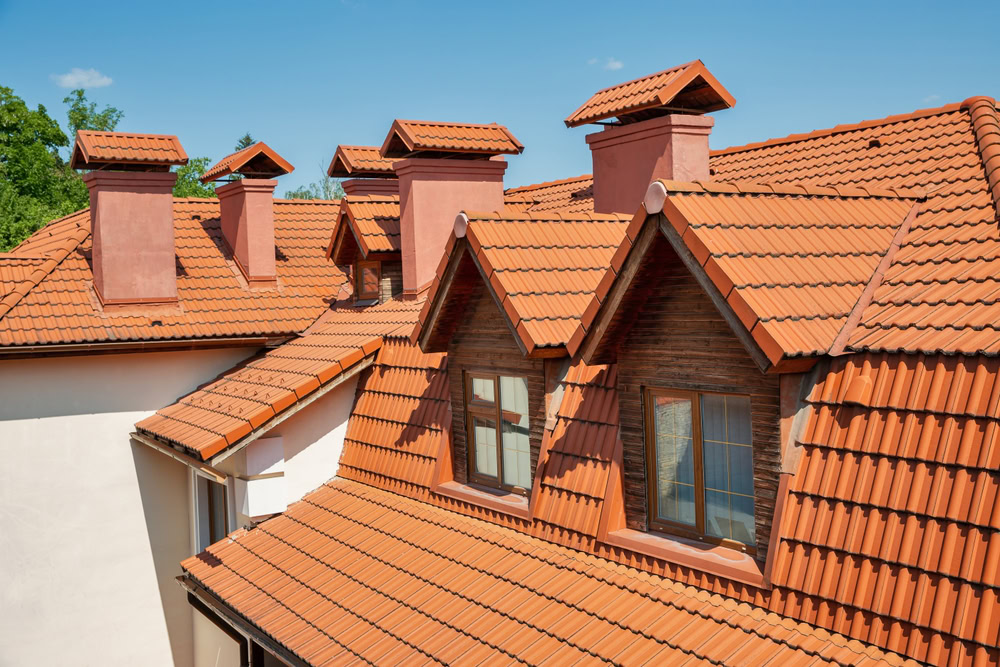For modern homeowners, “cool roofs” are in—and a Spanish tile roof absolutely qualifies.
According to the Cool Roof Rating Council (CRRC), clay and terracotta roofing tiles meet its cooling standards. Those tiles reflect 25% more of the sun’s rays than typical roofing materials, leading those houses to spend 20% less energy on cooling.
And it’s not just energy savings driving the Spanish tile roof trend.
Here at Above and Beyond Exteriors, our expert team is ready to guide you through this exciting roofing deep dive. What makes these rooftops so wonderful? And how can we maintain them well enough to last far beyond a single lifetime?
What Makes a Spanish Tile Roof Unique?
In the seven years since CRRC’s initial approval, almost all terra cotta and clay roofing tiles have earned certification.
Beyond cooling, Spanish tile roofs offer extraordinary benefits: they keep homes warmer on cold nights, readily withstand harsh weather, and resist the damage-causing moisture certain other types of roofs are prone to.
Moreover, today’s Spanish tile roofs don’t need to be made of terracotta if the material isn’t regionally appropriate. Roofing specialists now get the same benefits from a range of metals, slate, and synthetics mimicking the Spanish design.
One of its most popular benefits? Spanish tile rooftops have considerable longevity, despite requiring relatively little maintenance.
Yet, low-maintenance isn’t no maintenance. So what does the roof’s maintenance-to-lifespan ratio look like in practice?
How Long Does a Spanish Tile Roof Last?
With regular-enough inspection, cleaning, and repairs, a Spanish tile roof can last for centuries.
The Washington Irving mansion, built in Tarrytown, New York in 1656, still retains its original Spanish-style tiles on its rooftops. That’s a lifespan of over 360 years—and counting!
But, to get these results, effective maintenance and preservation efforts are vital. And, while it’s best to get expert advice specific to your roof, this maintenance checklist is a great place to start.
Maintaining Your Spanish Tile Roof: Tips and Tricks Checklist
As roofing specialists, we want your roof to last a lifetime. With this checklist, you’re all set to get started.
Start With Safety
Roofing maintenance requires smart, secure ladder use and appropriate protective gear. Workman’s gloves with a strong grip, anti-slip shoes, and PPE (hard hats and safety goggles) are crucial for safe roof maintenance.
To get on and off your roof safely, make sure your ladder extends at least three feet higher than the roof. The ladder must have all feet firmly planted on the ground at all times.
Inspect
The General Services Administration recommends public and commercial buildings undergo professional roofing inspections twice per year. Personal homes generally only benefit from annual inspections, unless there are signs of a problem.
To discover those signs, engaging in personal inspections can be worthwhile. When inspecting, look for:
- Cracks
- Chipped materials
- Rusk
- Discoloration
- Moisture
- Leaks
- Inappropriate gaps
- Signs of mold, mildew, or weed damage
Inspect your rooftop thoroughly. Examine any chimneys, exhaust stacks, and vents. Explore edges of insets and attachments (like skylights and solar panels). Gently test the security of tiles, and note any that are loose or missing.
Finally, inspect the insulation and roofing underlayer. This last inspection might require examining your roof’s underside, perhaps through your attic.
Clean
It’s wise to clean a tile roof at least every six months, in a humid climate.
When cleaning your tile roof, start from the topmost point and work downward. This way, runoff from your wash won’t pour wet dirt on the tiles you just cleaned.
Start cleaning by puting on workman’s gloves, then using a scrub brush, water, and a roof cleaning concentrate or solution spray to wash away moss, algae, weeds, dirt, and debris. You may need a prong weeder to remove more stubborn weeds from your tiles.
Then, use a power washer on low to rinse off remaining debris. If mold or mildew is a significant problem, you may want apply a zinc sulfate powder to prevent its regrowth.
After washing and weeding, return to ground level and clean your roof’s gutters. Use an extended gutter brush or wet/dry vacuum to clear out your gutters safely.
Repair
Spanish tile roof repair can be complex; in general, it’s wisest to seek expert repair services.
Roof repair can encompass fixing or replacing cracked or damaged tiles; patching up any holes or tears in your chimney, skylights, flashing, or seals; and applying both fresh paint and protective coatings to your roof.
To DIY, use a roof repair kit with caulk or sealant to fill holes, mend tiles, and repair cracks. Follow the kit manufacturer’s directions closely. Be sure to select a kit that’s compatible with your roof’s materials.
Replace
When you have leaks, a damaged roof underlayment is often the culprit. The roof’s underlayer needs to be replaced every 20-25 years, on average. In contrast, tile lifespans vary significantly; they only need to be replaced when they’re visibly cracked, broken, or missing.
In either circumstance, replacement requires professional expertise. When there are signs your roof is replacement-ready, don’t wait. Call in a specialist as soon as possible.
How To Choose a Roofing Contractor
Of course, the best way to maintain your roof is to connect with professionals. At a minimum, make sure any service you choose has up-to-date insurance and professional licenses in your state.
Then, ask potential roofers for client testimonials or references; dedicate some time to following up with a few of these references personally, to independently verify the nature and quality of the work the contractor had done for them.
Expert Remodelling, Maintenance, and Repair—All Under One Roof
At Above & Beyond, we get roofing jobs done right. Our home exterior experts are ready to take on even the toughest jobs: from complete tip-to-top remodeling to precision roofing maintenance and repair. If you need Spanish tile roof maintenance—or have any other building exterior quandary—call us at 908-588-9575. Or, contact us online for a free estimate! Our specialists are standing by.


 (908) 588-9575
(908) 588-9575